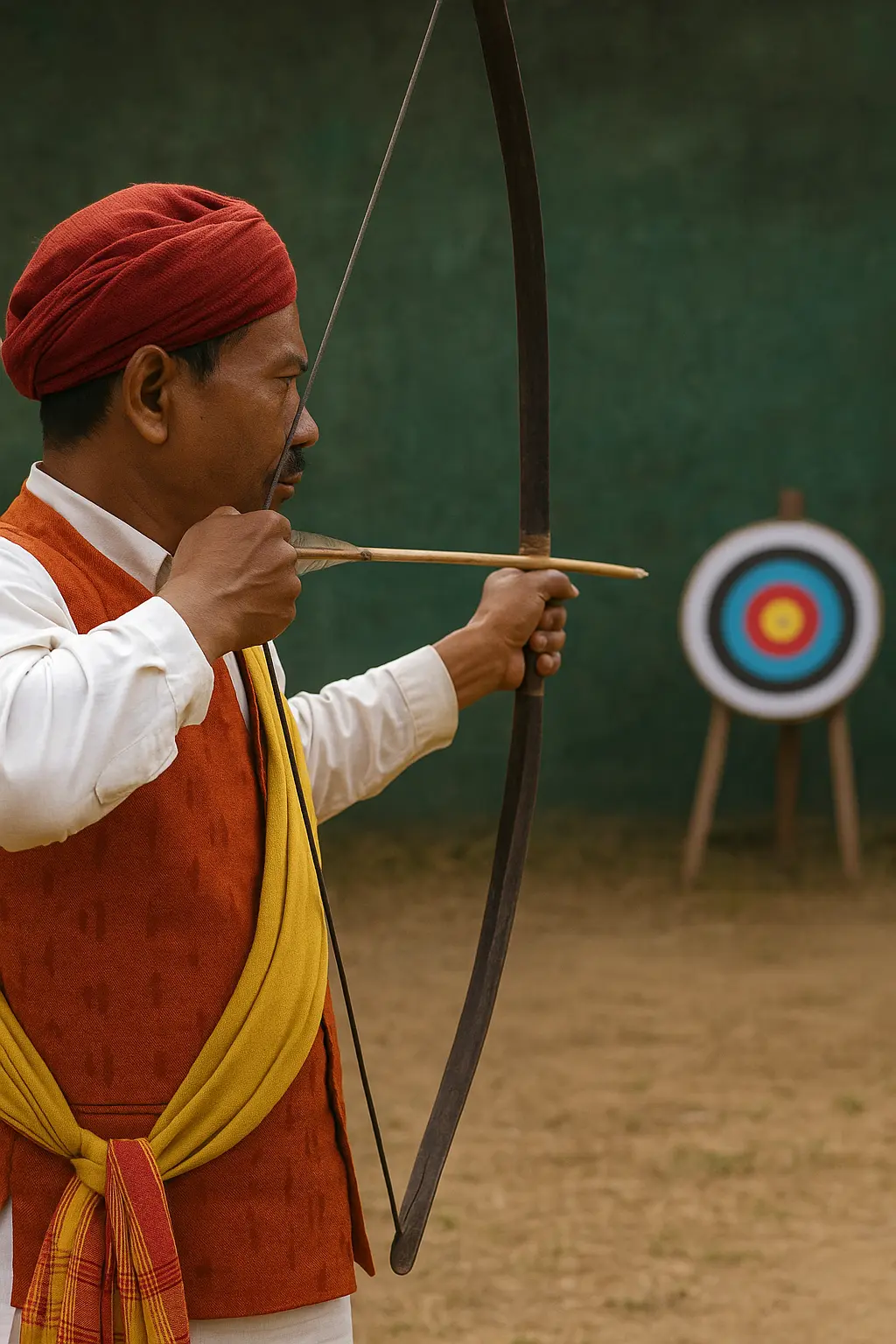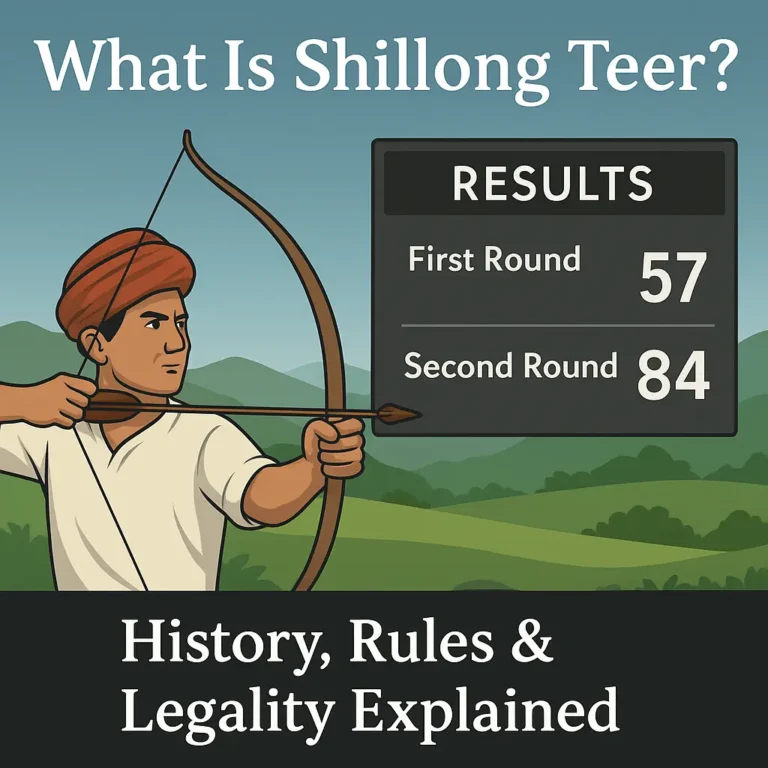What Is Shillong Teer? History, Gameplay & Rules Explained
Shillong Teer is a traditional archery-based number game deeply rooted in the cultural fabric of Meghalaya, India. Unlike conventional lotteries, Shillong Teer combines the skill of archery with number prediction, making it a unique and culturally significant activity. Recognized officially under the Meghalaya Amusements and Betting Tax Act, it is managed by the Khasi Hills Archery Sports Association and continues to thrive as a daily event in Shillong.
A Traditional Archery-Based Number Game in Meghalaya
The origins of Shillong Teer can be traced back to the early 20th century, rooted in local archery traditions of the Khasi tribe. Initially a community event, it evolved into a formalized game that reflects the rich heritage of the region. Every day, except Sundays and public holidays, skilled archers gather to participate in this event, where the number of arrows hitting the target determines the winning numbers.
The game is played in two rounds: in the first round, 50 archers shoot 30 arrows each, and in the second round, they shoot 20 arrows each. The total number of arrows that hit the target in each round is counted, and the last two digits of this count form the winning number for that round. Reddit
Shillong Teer is not just a game but a reflection of the community’s traditions and social interactions. It fosters community bonding as participants and spectators gather daily, sharing experiences and engaging in this culturally significant practice.
Historical Background of Teer
Shillong Teer traces its roots to the traditional archery practices of the Khasi tribe in Meghalaya. Historically, archery was not only a means of defense and hunting but also a significant cultural activity. Over time, these practices evolved into organized competitions, laying the foundation for what is now known as Shillong Teer.
In the 1970s, as the popularity of these archery contests grew, the need for regulation became apparent. Initially, the game faced legal challenges and was banned until 1981 due to concerns over unregulated betting activities. However, recognizing its cultural significance and potential for economic contribution, the government of Meghalaya legalized and formalized the game under the Meghalaya Amusements and Betting Tax Act. The Khasi Hills Archery Sports Association (KHASA) was established to oversee the fair conduct of the game. This organization ensures that the traditional aspects of the game are preserved while maintaining transparency and fairness in its operations. Today, Shillong Teer stands as a testament to the region’s rich cultural heritage, blending tradition with modern regulatory frameworks.
How the Shillong Teer Game Works
Shillong Teer is a unique blend of traditional archery and number prediction, deeply embedded in the cultural fabric of Meghalaya. Organized by the Khasi Hills Archery Sports Association, the game is held daily, except on Sundays and public holidays, at the Polo Ground in Shillong.
Daily Structure: Two Rounds of Archery
The game comprises two rounds:
- First Round (3:45 PM): 50 archers shoot 30 arrows each at a cylindrical bamboo target.
- Second Round (4:45 PM): The same archers shoot 20 arrows each.
The total number of arrows hitting the target in each round is counted, and the last two digits of this count form the winning number for that round.
Participation: Archers and Ticket Buyers
Participants can engage in the game in two ways:
- Archers: Skilled individuals who participate in the shooting rounds.
- Ticket Buyers: Individuals who purchase tickets and predict the outcome numbers.
Tickets are available at authorized counters from 10:00 AM to 3:30 PM, with numbers ranging from 00 to 99.
Result Calculation: From Arrows to Numbers
After each round, officials count the number of arrows that hit the target. For example, if 1,090 arrows hit the target, the winning number is 90.
Rules & Format of the Shillong Teer Game
Shillong Teer is a unique archery-based number game regulated by the Meghalaya Amusements and Betting Tax Act. The game is conducted under strict guidelines to ensure fairness and transparency.
Game Schedule and Structure
- Days Played: Monday to Saturday; no games on Sundays and public holidays.
- Rounds: Two rounds are held daily:
- First Round: Begins at 3:45 PM.
- Second Round: Begins at 4:45 PM.
Each round involves 50 archers shooting a set number of arrows at a target.
Ticket Purchase and Number Selection
- Ticket Sales: Available from 10:00 AM to 3:30 PM at authorized counters.
- Number Range: Players select numbers between 00 and 99.
- Betting: Players place bets on their chosen numbers, predicting the last two digits of the total number of arrows hitting the target.
Result Calculation
After each round, the total number of arrows hitting the target is counted. The last two digits of this count determine the winning number for that round. For example, if 1,090 arrows hit the target, the winning number is 90.
Regulations and Compliance
The game is governed by the Meghalaya Regulation of the Game of Arrow Shooting and the Sale of Teer Tickets Act, 2018. Key regulations include:
- Licensing: Organizers and bookmakers must obtain licenses from the state government.
- Ticket Sales: Only government-authorized tickets are permitted.
- Age Restriction: Participants must be 18 years or older.
- Timing: Games are conducted within specified hours to maintain order and discipline.
Is Shillong Teer Legal?
Shillong Teer is a traditional archery-based number game that holds legal status in the state of Meghalaya, India. Its legality is established and maintained through specific legislative acts and regulations enacted by the state government.
Legalization and Regulatory Framework
The game was officially legalized in 1982 under the Meghalaya Amusements and Betting Tax (Amendment) Act. This act provided a structured framework for the regulation and taxation of the game, ensuring its operation within the legal parameters set by the state.
In 2018, the Meghalaya Regulation of the Game of Arrow Shooting and the Sale of Teer Tickets Act was introduced to further refine the legal structure governing Shillong Teer. This act outlines the procedures for licensing, the responsibilities of organizers and bookmakers, and the rules for conducting the game. It also specifies the conditions under which the game can be played, ensuring transparency and fairness in its operation.
Licensing and Oversight
The Khasi Hills Archery Sports Association (KHASA) is the primary body responsible for organizing and overseeing Shillong Teer. Under the 2018 act, organizers and bookmakers are required to obtain licenses from the state government to conduct the game and sell tickets. These licenses are issued with specific terms and conditions to maintain the integrity of the game.
Regular inspections and monitoring are conducted to ensure compliance with the established rules and regulations. Any violations can lead to penalties, including the suspension or revocation of licenses, as stipulated in the governing acts.
Cultural Significance and Legal Recognition
Shillong Teer is not merely a game but a cultural tradition deeply embedded in the social fabric of Meghalaya. Its recognition and regulation by the state government underscore its importance to the local community. By providing a legal framework for its operation, the government acknowledges the game’s cultural significance while ensuring it is conducted responsibly and ethically.
Cultural Relevance & Public Interest
Shillong Teer is more than just a game; it is a cultural phenomenon deeply embedded in the social fabric of Meghalaya. Originating from the traditional archery practices of the Khasi tribe, Teer has evolved into a daily ritual that fosters community bonding and reflects the region’s rich heritage.
Teer as a Community Gathering
Every afternoon, locals gather at designated Teer counters and archery grounds, not just to participate in the game but to socialize and share experiences. These gatherings serve as communal events where stories are exchanged, and traditions are upheld, strengthening social ties among participants.
Economic and Social Impact
Teer contributes to the local economy by providing employment opportunities for archers, ticket sellers, and others involved in organizing the game. Additionally, the game’s popularity attracts visitors, promoting tourism and supporting local businesses. The revenue generated is often utilized for community development initiatives, further enhancing its significance in the region.
Preservation of Cultural Heritage
The continued practice of Teer ensures the preservation of traditional archery skills and the associated cultural narratives. By engaging younger generations in the game, the community passes down valuable traditions and maintains a sense of identity rooted in their ancestral customs.
Responsible Participation & Common Myths
Shillong Teer is more than just a game; it’s a cultural tradition deeply rooted in the community. However, like any form of entertainment involving predictions, it’s essential to approach it responsibly and be aware of common misconceptions.
Embracing Responsible Participation
- Set Personal Limits: Determine a budget for participation and stick to it. This ensures that the game remains a fun activity without financial strain.
- Understand the Game: Familiarize yourself with the rules and structure of Shillong Teer. Knowledge enhances the experience and reduces misconceptions.
- Avoid Chasing Losses: If predictions don’t yield desired results, resist the urge to invest more in hopes of recovering losses.
- Seek Support if Needed: If participation becomes overwhelming, consider seeking guidance or support to maintain a balanced approach.
Debunking Common Myths
- Myth: “There are guaranteed methods to predict winning numbers.” Fact: While some enthusiasts analyze patterns, Shillong Teer outcomes are inherently unpredictable.Fimfiction
- Myth: “Playing more increases chances of winning.” Fact: Each round is independent, and increased participation doesn’t guarantee success.
- Myth: “Only locals can understand and play the game effectively.” Fact: Shillong Teer welcomes participants from all backgrounds, and understanding the game is accessible to all.
Promoting a Healthy Gaming Culture
Community leaders and organizers emphasize the importance of maintaining the cultural essence of Shillong Teer. Educational initiatives and awareness campaigns are in place to ensure participants engage with the game responsibly, preserving its integrity and significance in the community.
Final Thoughts – Tradition Meets Regulation
Shillong Teer is more than just a game; it is a cultural tradition that reflects the rich heritage of Meghalaya. Rooted in the archery practices of the Khasi tribe, it has evolved into a regulated activity under the Meghalaya Amusements and Betting Tax Act. This blend of tradition and regulation ensures that the game remains a significant part of the community’s social and economic fabric.
The game’s structure, involving skilled archers and community participation, fosters a sense of unity and cultural pride. Moreover, the revenue generated contributes to local development, highlighting its economic impact. As Shillong Teer continues to thrive, it stands as a testament to the harmonious coexistence of cultural preservation and modern governance.
FAQ – Quick Answers About Shillong Teer
Q1: Is Shillong Teer a form of gambling?
A: Shillong Teer is a traditional archery-based number game regulated by the Meghalaya Amusements and Betting Tax Act. It is legally recognized and culturally significant in Meghalaya.
Q2: How are the winning numbers determined?
A: The winning numbers are based on the total number of arrows hitting the target in each round. The last two digits of this count form the winning number.
Q3: Can anyone participate in Shillong Teer?
A: Yes, individuals aged 18 and above can participate by purchasing tickets from authorized counters and selecting numbers between 00 and 99.
Q4: Where can I check the results of Shillong Teer?
A: Results are announced daily after each round and can be checked at authorized counters or online platforms dedicated to Shillong Teer updates.
Q5: Is Shillong Teer played every day?
A: The game is played from Monday to Saturday. There are no games on Sundays and public holidays.


